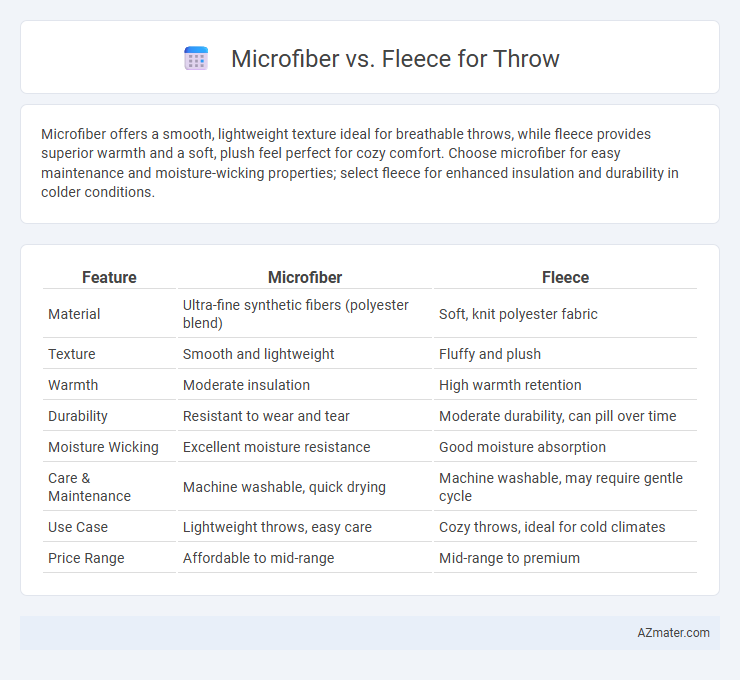Microfiber offers a smooth, lightweight texture ideal for breathable throws, while fleece provides superior warmth and a soft, plush feel perfect for cozy comfort. Choose microfiber for easy maintenance and moisture-wicking properties; select fleece for enhanced insulation and durability in colder conditions.
Table of Comparison
| Feature | Microfiber | Fleece |
|---|---|---|
| Material | Ultra-fine synthetic fibers (polyester blend) | Soft, knit polyester fabric |
| Texture | Smooth and lightweight | Fluffy and plush |
| Warmth | Moderate insulation | High warmth retention |
| Durability | Resistant to wear and tear | Moderate durability, can pill over time |
| Moisture Wicking | Excellent moisture resistance | Good moisture absorption |
| Care & Maintenance | Machine washable, quick drying | Machine washable, may require gentle cycle |
| Use Case | Lightweight throws, easy care | Cozy throws, ideal for cold climates |
| Price Range | Affordable to mid-range | Mid-range to premium |
Introduction to Microfiber and Fleece Throws
Microfiber throws are crafted from ultra-fine synthetic fibers designed to provide exceptional softness, durability, and moisture-wicking properties, making them ideal for year-round use. Fleece throws, made from polyester, mimic the warmth and texture of wool while being lightweight, breathable, and quick-drying, perfect for cozy indoor and outdoor environments. Both materials offer easy care and resistance to shrinking, but microfiber excels in smoothness and stain resistance, whereas fleece is favored for insulation and warmth retention.
Material Composition: Microfiber vs Fleece
Microfiber throws are crafted from ultra-fine synthetic fibers, primarily polyester, that provide a smooth, lightweight, and tightly woven texture known for durability and water resistance. Fleece throws, often made from polyester or polyester blends, feature a napped, thicker construction that traps air for superior warmth and softness. The material composition of microfiber ensures quick drying and stain resistance, while fleece offers enhanced insulation and a plush feel, making each suitable for different comfort and care preferences.
Softness and Comfort Comparison
Microfiber throws are renowned for their ultra-soft, suede-like texture that offers a lightweight yet cozy feel, making them ideal for sensitive skin and everyday use. Fleece throws provide exceptional warmth and plush thickness, delivering a cloud-like comfort perfect for colder environments and heavy insulation. Both materials excel in softness, but microfiber tends to be smoother and finer, while fleece boasts a fluffier, more cushioned touch.
Warmth and Insulation Differences
Microfiber throws offer lightweight warmth with fine fibers that trap heat efficiently, providing excellent insulation without bulk. Fleece throws, made from densely knit synthetic fibers, deliver superior warmth through a thick, plush texture that retains heat even in colder conditions. While microfiber excels in breathability and moisture-wicking, fleece outperforms in maximum insulation and cozy comfort during extreme cold.
Breathability and Moisture-Wicking Properties
Microfiber throws excel in breathability and moisture-wicking properties due to their ultra-fine synthetic fibers that allow air circulation and efficiently draw moisture away from the skin, keeping you dry and comfortable. Fleece blankets, made from polyester, offer warmth and softness but generally have lower breathability and moisture-wicking capabilities compared to microfiber, making them less ideal for regulating temperature during extended use. Choosing microfiber provides enhanced ventilation and moisture management, ideal for those prone to overheating or sweating under a throw.
Durability and Longevity
Microfiber throws exhibit superior durability due to their tightly woven synthetic fibers that resist pilling, tearing, and wear over time. Fleece throws, while soft and warm, tend to pill more easily and may lose their texture after repeated washing and heavy use. Microfiber's strength and resistance to fading contribute to its longer lifespan, making it a preferred choice for longevity in throw blankets.
Maintenance and Care Instructions
Microfiber throws require regular machine washing in cold water with mild detergent to prevent fiber matting and maintain softness, and should be air-dried or tumble dried on low heat to avoid damage. Fleece throws benefit from gentle washing in cool water to preserve their plush texture, avoiding fabric softeners or bleach that can degrade the fibers, and should be dried on low heat or air-dried to prevent pilling. Both materials respond best to minimal exposure to high heat and should be stored in dry, well-ventilated areas to maintain their durability and appearance over time.
Allergen and Skin Sensitivity Considerations
Microfiber throws are hypoallergenic and resistant to dust mites, making them ideal for individuals with allergies or sensitive skin. Fleece throws, while soft and warm, can sometimes cause irritation or itching for those with extremely sensitive skin due to their synthetic fibers. Choosing microfiber minimizes allergen exposure and supports better skin comfort in allergy-prone users.
Cost Analysis: Microfiber vs Fleece
Microfiber throws generally cost less than fleece throws due to cheaper raw material and manufacturing processes, making them a budget-friendly option. Fleece throws, often made from polyester, tend to be more expensive owing to their thicker, warmer fabric and durability. Comparing prices reveals microfiber offers a balance of softness and affordability, while fleece provides enhanced warmth at a higher price point.
Best Uses and Final Recommendations
Microfiber throws excel in moisture-wicking and stain resistance, making them ideal for outdoor use and households with pets or children. Fleece throws provide superior warmth and softness, perfect for indoor relaxation and cold-weather layering. Choose microfiber for durability and easy maintenance, while fleece is best for cozy comfort and insulation.

Infographic: Microfiber vs Fleece for Throw
 azmater.com
azmater.com